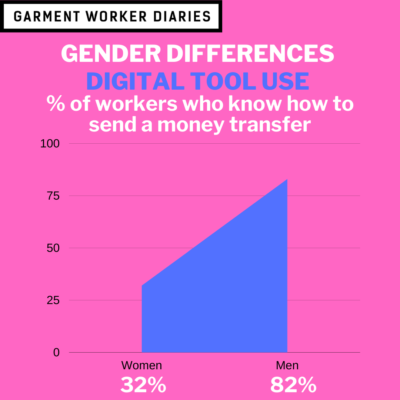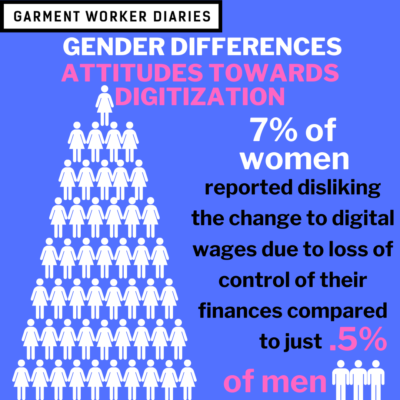Over the past ten weeks garment workers in Bangladesh have experienced many changes. Wage digitization stands out as one of the most significant changes workers have reported to MFO and SANEM. The ready-made garment sector has flipped from being cash-based to digitally-dominant in just a few short weeks.
This immersion into the new world of ATMs, PIN numbers, debit cards, mobile money agents, paperless receipts, and impersonal, remote money transfers to family members has not played out the same for everyone. The experiences of wage digitization have been different for women and men, as have been their uptake and understanding of certain digital tools. Before-and-after attitudes towards wage digitization have also changed since the COVID-19 pandemic, so we’ll explore those too.
Wage Digitization Experiences
Overall levels of satisfaction with wage digitization have been positive, with 65% of respondents reporting that they “like” wage digitization. The gap between women and men reporting that they like wage digitization is wide, however, with 62% of women reporting positive feelings towards it and 77% of men reporting the same. Other gaps between women’s and men’s attitudes were evident throughout the survey:
- When asked whether they were “comfortable” with the new system, 62% of women said they were comfortable compared to 82% of men
- When asked to select the reason(s) for liking the change to digital wages, men reported more positive feelings than women in every single possible category, with sometimes wide margins. Overall:
- More men (44%) than women (20%) reported that they liked the increased transparency digitization offers
- More men (42%) than women (21%) reported enjoying being able to make transactions from home
- More men (42%) than women (24%) reported the ease of transferring money being the reason they felt positive towards digitization
- When asked to select the reason(s) for disliking the change to digital wages, women reported more negative feelings than men in five out of nine categories. Overall:
- More women (17%) than men (6%) reported that they simply did not know how to use the new digital system
- More women (29%) than men (8.5%) also reported that the process of using the new digital system was too difficult
- 7% of women reported disliking the change due to loss of control of their finances against only 0.5% of men citing this change
Digital Tool Use
The differences between women and men in reported digital tool use were stark:
- 90% of men reported that they can withdraw money without help, whereas 55% of women reported being able to do so
- 91% of men reported that they can check their balance without help, whereas 58% of women reported being able to do so
For many garment workers, making cash transfers between family and friends is a commonplace occurrence, whether inside or outside the household. And for certain garment workers, cash gifts, loans, or other timely hand-offs of liquidity from friends and family are vital components of their financial well-being. The data from our survey suggest a large difference in the ability of men and women to conduct such a transfer digitally:
- 82% of men reported that they can transfer money without help, whereas only 32% of women reported being able to do so
When we compare attitudes among those who received information on wage digitization and those who did not, we see a hint that financial education makes a difference:
- Among women receiving education on digitization, 67% liked the change and 32% still did not (with 1% having no preference)
- However, among women receiving no education on digitization, 47% liked the change and 51% did not (with 2% having no preference)
This closing of the gap between those who like and dislike wage digitization and the correlation between whether they received financial education might indicate that no education does not bode well for positive uptake of new digital tools.
Before and After COVID-19
41% of the respondents interviewed were “digitized” before COVID-19, and 59% were digitized after. The differences in those digitized before and after are worth noting:
Like or Dislike Digitization
- Of those respondents who were digitized before COVID-19, 78% report positive feelings towards digitization;
- Of those respondents who were digitized after COVID-19, 56% report positive feelings towards digitization
Comfort with Digitization
- For those digitized before COVID-19, 82% felt comfortable with the system
- For those digitized after COVID-19, 56% felt comfortable with the system
Information Transmission
73% of the respondents who were digitized either before or after COVID-19, received some kind of information on digitization. The proportionate methods of information transmission are different before and after COVID-19, however:
- Before COVID-19, the primary methods of information transmission were (respondents could select more than one): learning at home or from friends (42% of respondents learned of digitization this way); individual sessions (40%); written materials (36%); loudspeaker announcements (33%); trainings (21%); and group sessions (20%)
- After COVID-19, the primary methods of information transmission were (respondents could select more than one): written materials (47%); learning at home or from friends (35%); loudspeaker announcements (34%); individual sessions (19%); trainings (21%); and group sessions (7%)
All data presented here come from interviews conducted over the phone with a pool of 894 workers who reported being paid digitally. These workers are employed in factories spread across the five main industrial areas of Bangladesh (Chittagong, Dhaka City, Gazipur, Narayanganj, and Savar). Just over three-quarters of the working respondents are women, roughly representative of workers in the sector as a whole.



